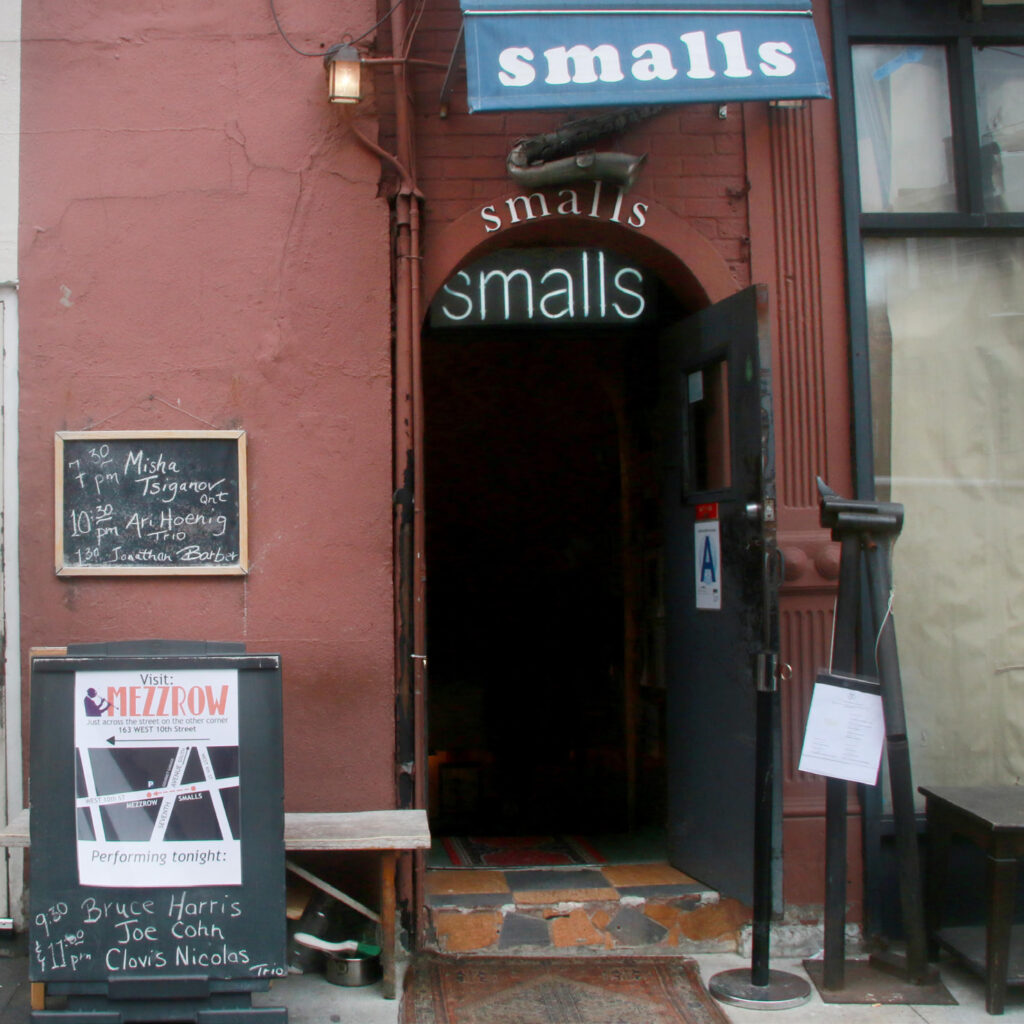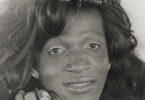
The Smalls Jazz Club, January 1, 2021. Covid-19 is still going about its horrific business in New York City, but as dusk darkens the semi-deserted streets in the West Village, five musicians are setting up to play to an invisible audience in a basement room on West Tenth Street. They will be paid for two sets of music. Despite formidable odds, the tiny and now legendary Smalls Jazz Club is still going about its business.
My introduction to Smalls took place on a steamy summer night, a year or so after it first opened in 1994. A good friend made the introduction. Unlike me, he lived in Manhattan and kept up with the changing jazz scene there. We went first to Bradley’s, the popular Village piano bar at 70 University Place where so many of the world’s greatest jazz pianists routinely took a seat at the club’s nonpareil Steinway grand. (I lived 500 miles from Manhattan, but I knew about Bradley’s because I was a hungry reader of critic Whitney Balliet’s jazz columns and Joan Bennett’s pithy, on the money jazz blurbs in the New Yorker.)
After a stirring set by the young pianist Jeff Keezer, my friend said we should check out one more place. “It’s a new club in the West Village.” Minutes later we were waved past a battered open door and the sixteen steps that lead to the basement home of Smalls Jazz Club. The musicians were on break, but the room definitely wasn’t. It was packed with mostly young jazz fans, brightly lit and noisy. The vibe was electric and everyone seemed to be talking at once. But soon enough, like a monitor being turned to low, the talking began to fade. The musicians were back on the bandstand and ready to start another set.
First Incarnation
According to its own website, “Smalls Jazz Club was created in 1994 by the enigmatic Mitchell Borden, a former Navy submariner, registered nurse, philosopher & jazz violinist.” Borden, who retired from Smalls in 2019, had little experience in business and an even smaller interest in making money beyond keeping the club open. He did have a transcendent, almost mystical devotion to jazz music, its history, its great legends and its universal appeal to different peoples and races around the world. He also lamented the shrinking number of clubs in New York that were paying higher rents that resulted in higher covers, and which left countless young musicians without a place to develop their art before a live audience. But when he learned that he could lease the small dingy basement on West 10th, he jumped. It was kind of a dump, but so what.
Word of mouth spread quickly after Smalls opened. Patrons could usually find Borden outside on the sidewalk chatting or barking at potential customers. And if you didn’t have the modest ten-dollar cover, Borden might let you hand over what you did have. He was known for letting temporarily homeless musicians sleep at the club. He welcomed others who showed up during the day when they were desperate for a place to practice or lacked access to a piano.
The saxophonist Charles Owens, who had a regular Friday night gig at the club for years, also often opened and closed it in those early years. In a recent radio interview, he said that the jam sessions the club encouraged would frequently last until six or eight in the morning. (Jam sessions provide a testing ground for young, inexperienced musicians in ways that formal schooling can’t. They can encourage players to work harder, help overcome stage fright or “freezing up” when improvising, and can introduce young players to established older ones who are on the lookout for an exceptional young talent to add to their band.)
Some of the tonier neighbors and shops near the club were appalled by it, even though in those days it didn’t even have a liquor license. (Likely some of these feared as much about racism and property values as anything else.)
When booking musicians, Borden especially liked players who, despite the closed doors at other clubs, were passionate about experimenting and making something new out of the classic jazz standards. And history shows that Borden had an exceptional pair of ears and sense of timing when it came to bookings. Players as diverse as Norah Jones, Joshua Redmond, Roy Hargrove, Chris Potter, Jeremy Pelt, Mark Turner, Brad Mehldau, Guillermo Klein and hundreds of others played at Smalls at the start of their careers. It was an amazing run that lasted until 2002. Then, shortly after 9/11, Smalls, too, came crashing down and declared bankruptcy.
Second Incarnation
Smalls was dormant but hardly forgotten by musicians and Mitch Borden. Two years later the club was back for a second incarnation. Another quote from the Smalls website: “Smalls was taken over by a Brazilian bar owner who renamed the place ‘The Rio Bar’, which became a dismal failure. Frustrated by his failure, he approached Borden and asked him to re-open Smalls with him(self) as owner and (Borden) as manager.” Once again up and coming jazz musicians in New York and even Europe were performing at Smalls.
The new arrangement seemed to work until early 2007 when the Brazilian declared he wanted to sell the club. That is when the pianist Spike Wilner enters our story.
Wilner, along with a friend of his and Borden, raised the funds to buy the club in a three-way partnership. Wilner had a knack for the business side of things Borden lacked. But all three partners developed a new vision of what Smalls should now be. They restored the basement, added chairs and better lighting and set up a new sound system that eventually included video. This meant that the club could archive each live show and offer them to schools and universities. (Last year, to help ensure it’s survival, Wilner set the club up as a not-for-profit called the SmallsLIVEFoundation). Soon enough, another generation of young jazz players and aficionados were finding a home at Smalls again. As usual, guest players would be asked to sit in, but the all-night jam sessions were a thing of the past. It still wasn’t the most profitable jazz venue in town, but with the Foundation and a partnership that shared the jobs of booking, management and accounts, it was on a much more even keel, even after the partnership was reduced to just Wilner and Borden.
Third Incarnation
As I write, Smalls today is in what could be called its third incarnation. As the rich fled the city last year with their computers and servants and planted their families in second or third homes, ambulance sirens, death and bizarre illnesses became omnipresent in the city. The throng of ordinary people who keep it humming and make life here bearable were often left to fend for themselves. Most New Yorkers who work in the performing arts suffered. Jazz musicians, who lacked a sinecure at a university or a Lincoln Center, or lacked the skills to use digital technology, were left high and dry. In step with the city’s concert halls and theatres, the city’s jazz clubs began closing, too, some for good. But once again, Smalls was an exception to the rule.
The club never stopped paying musicians to present live shows for ten to fifteen socially-distanced paying customers –or for no customers at all when lockdown demanded it. But there were eyes and ears pinned to phones and laptops, also watching these shows. It was an invisible audience which the musicians, sadly, could neither see no hear, but knew was there. Some sixty thousand streamed SmallsLIVE when Wynton Marsalis took the little bandstand. However many of the concerts I saw were equally memorable. Some of my favorites were a group fronted by the great Philadelphia pianist, Orrin Evans which featured Caleb Curtis, a brilliant young alto sax player from Brooklyn; the astounding young jazz vocalist, Veronica Swift and her quartet; and tenor saxophonist Melissa Aldana and her phenomenal guitarist, Charles Altura, not to mention the brilliant pianist, Sullivan Fortner.
The pandemic has made the future status of such things, cherished by people, impossible to predict. Who knows if Smalls will still be open when you’re reading this. But, damn, it better be. G&S
For more info go to smallslive.com





Leave a Comment